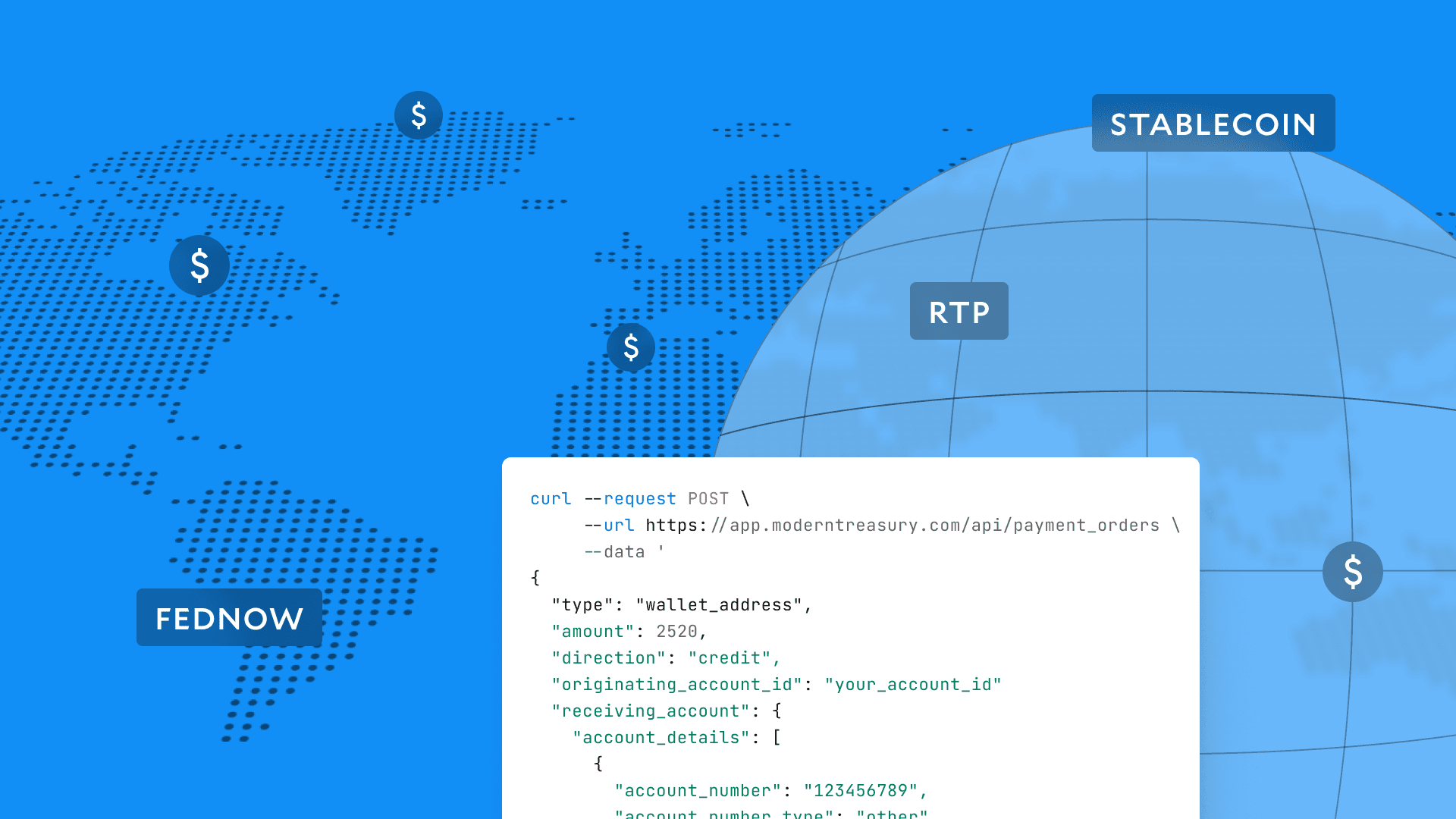Modern Treasury and Paxos Make It Easier for Businesses to Move Money with Stablecoins.Learn more →
Modular Innovation: Takeaways from our Tech Talk
Modern Treasury recently hosted a Tech Talk on driving digital transformation through modular upgrades to payment infrastructure. This journal shares key insights from in-house experts.

Modern Treasury’s payment operations platform combines a suite of APIs and dashboards to help companies manage money movement. To better understand how enterprises can modernize their payments infrastructure while dealing with the compounded complexity of systems and scale, we hosted a tech talk last week with Erica Libby, Product Manager, and Brian McKinney, Head of Payments Engineering, moderated by Molly Fischer, our Head of Enterprise Sales. Below is an edited excerpt—you can access the full Tech Talk here.
Q: What are the different components of a payment system—the large building blocks that most enterprises are working with?
Erica: Payment systems in large enterprises, and even in smaller companies, are extremely complicated. There is so much going on and so much that has to go right. Before delving into the specifics, payments are important to not only being an effective business, but of course, building trust with your customers and delivering that promise. So having all the right components is just so critical to being effective.
When I think about an effective and strong payment system, there's really five key components:
- Payment initiation: starting a payment using bank-based payments with traditional rails like ACH, to modern rails like FedNow, card based payments, and everything in between.
- Reconciliation: logging all payments and reconciling them against bank statements, against cash—making sure the money that's supposed to go out goes out to the right people.
- Compliance: ensuring rigor from KYC to KYB, AML, and other critical regulations.
- Ledgering: keeping track of who owes whom whatever amount of money in a double-entry ledger.
- Cash visibility and treasury: understanding which funds are in which accounts, what you're earning on those accounts, FX rates, all of that.
So there's really lots of components that are all interconnected. And the last piece I'll just mention is that this spans a lot of different teams, from engineering to product, to FP&A, to compliance and legal.
Brian: There's a lot of complexity, and it can be daunting from any perspective for one of those stakeholders. You might only know a piece of it. And that connects to other legacy systems or things that don't speak well together. The whole pipe is opaque; you don't understand the flow from beginning to end.
And folks, especially given the rate environment and given how fast technology is moving, are looking at their system with a new lens, saying, “Hey, if I can start to make small incremental change, I can drive not only greater visibility and greater buy-in from stakeholders, greater communication, but drive a competitive edge.”
Q: Why is there not a single solution that fits the needs enterprises have—why is it a patchwork of systems that we so frequently see?
Erica: To me, the primary reason is a lot of those components we talked about earlier are managed by different teams or different functions. And ultimately, what each of those teams needs can be quite different.
The team that's managing payment initiation at a fintech is likely building in-house direct to bank, direct to the networks, whatever it might be, because that's core infrastructure. Then you've got teams in accounting, focused on the general ledger and accounting software, and that's where ERPs are the right solution. And maybe you have a treasury team focused on optimizing interest rates and how to manage cash balances across different countries and different places, and the solutions that solve for that are also quite different.
So it comes from a place of disparate teams with disparate goals, and much of the available software at the time was just solving one problem at a time. Now we're in a place where software, as Brian said, has come so far, and payments have come so far, that we can actually start to think about how these parts work together.
Today we're really evolving to a place where companies like Modern Treasury are saying, “Can we solve this in a more holistic way and create that data visibility, that money movement visibility, that really helps connect these teams together and solve all the problems?”
Q: How do you think companies can manage the complexity and why is that important?
Brian: The complexity is natural. As Erica was highlighting, you make decisions with the best information of that day, with the budget you have that day, with whatever directive you're given.
In many cases, you're just trying to make your life easier. So these systems just naturally evolve from the software that's bought, the ecosystem that's built, and then even the organizations that are around it. And as a leader, it can be very daunting, because you realize there's a lot of opportunities here.
It really goes back to taking advantage of what the market has today and reevaluating where you want to spend your resources. So this idea of modularity makes sense. Find a small part, one stage in your pipeline—maybe it's reconciliation, because we know a lot of companies struggle with that particular area—and think about working with a vendor or kicking off a pilot.
And if you can solve it, especially if you can do it in a way where you reduce the amount of money you're spending on it, then you've proven value. Once you have momentum, it's easier for more and more of the company to get behind it. You get one part of the pipeline or one area really functioning well, then you repeat it and you repeat it and you repeat it.
Q: Have you seen companies successfully introduce new infrastructure sequentially?
Erica: I wouldn't say pick your battles, but maybe find the right moment and space for testing and having impact. At my old company, we wanted to launch a referral program; there was some skepticism, but we were aiming to meet a metric. We went out, and we found a vendor to help support us. We signed a relatively short-term one-year contract to help us build this thing in six weeks, and we're going to know if it works. And exactly to Brian's point, it was one of those demonstrations of a vendor being valuable and let's go repeat it elsewhere.
Q: How do you think about build versus buy when you don't see options that meet your needs, but your team is not sure how to build on their own?
Brian: I'm always a big fan of phone a friend here. I've been an engineering leader for 15 plus years now at small companies, big companies. As I've gotten older, I realized lots of people are facing the same struggle, so messaging them and asking: “Hey, you seem like you're in the same space as me; what are some of the struggles you're facing and how have you thought about them?” I've been really surprised about how open people are. It's really connected me with ideas or even just getting me out of this one world view.
Erica: We go back to the core competency question too: “Is this something that, if we build and we build ourselves, we're going to want to maintain 10, 15, 20 percent of our engineering time dedicated to this in a given quarter, and even in a given month?”
And if the answer to that question is no, and you can find a vendor that's meeting 70 percent of your needs today, they're more likely to build that 30 percent than you are, because you probably want to focus on what your core business is.
And sometimes you're going to find if the buy solution is only meeting 40 percent of your needs, maybe it makes sense to build because that team is only focused on that 40 percent. So it's a question of how far off that vendor might be from where you want to be and how core that capability is to the competencies that you have, the competencies that you want to have as a business going forward.
Q: What advice would you give leaders in terms of revamping and rebuilding their systems?
Erica: Be self-aware and acknowledge how daunting and scary it is to touch any part of one's payment stack. Anyone who's worked on payment stacks in different companies knows how scary that could be if something goes wrong. Start by acknowledging that risk; everyone in the room says, “Look, we know that this is scary, but we still believe that the value we can add by making improvements here is extremely critical. And here is how we’re bringing value to the business and customers by making enhancements.”
My second piece of advice is to focus on something that is really going to add meaningful impact to either customer or business—hopefully both—because it makes that risk-reward trade off worth it. Once you've done it, and done it effectively, with the right partners, you can feel confident to tackle some of those other pieces. That education piece, that learning piece, whether it's through consultants, through co-workers, through other people, through the evaluation of vendors and learning from them was really valuable as well. And having a strong perspective of what's most important to you—the goal we want to achieve, the payments we want to offer— because the information deluge can be quite big.
Next Steps
You can access the full Tech Talk here.
Modern Treasury enables companies to automate payments from end-to-end, including reconciliation, payment orchestration, and ledgering. If you are interested in learning more, reach out to us.




